General data Area: 49 000 km²
Population: 5,4 millions
Density: 111 inhab/km²
Capital: Bratislava
Languages: Slovakian, Hungarian
Ethnic groups: Slovaks (86%), Hungarians (10%)
Religion: catholic
GDP per capita: 13270 €
Reproduction rate: 1,33
Life expectansy: 74 years
Currency: Euro |  |
Very early, to 10th and 11th century, the territory of present-day Slovakia passes under Hungarian control. The Czech influence is however important at the time of the great religious conflicts (Hussites ideas in the 15th century). Despite the victory of the Hungarian King Mathias Corvinus in 1467, these events make the identity's and the Slovak language's originalities emerge. At this occasion, protestantism makes advances. The Turkish invasion of Hungary does not reach Slovakia, but transforms this country into refuge in front of the loss of the Hungarian country. The Counter-Reformation takes again the lead religiously. When the Turks are chased out from Hungary in the 17th century, the Slovaks take part in repopulation, while, even in their country, they remain enslaved. Submitted to the Magyarization in the 1870's, the Slovaks massively emigrate in the United States. The idea of a union with the Czechs progresses.
Faithful with Austria-Hungary during WW I, Slovaks are attracted by the action of exiled Czechs, Masaryk and Benes, who were joined by the Slovak Stefanik. If the Allies are dubious on the fate of the nations composing the Austro-Hungarian empire, they will accept the proclamation of this new state by Masaryk on October 14, 1918.
The determination of the borders on the Slovak side not answering historical concepts, it thus reflects ethnical concepts. It however includes, in the south, a strong Hungarian minority, such an Ukrainian minority in Ruthenia.
Administrative frustrations, generated by the Czechs, quickly harboured the Slovak particularism.
The cutting-up of 1938/1939 will involve the autonomy of Slovakia, led by the pro-Nazi Mgr Tiso, while Hungary obtains the south of the country. An important anti-Nazi resistance settles then. Soviet troops enter in Bratislava in April 1945. The end of WW II involves a come back to the borders of 1937, except for Slovak Ruthenia which returns to the Ukraine.
The Slovak history merges with that of the Czech countries during the communist era: "coup of Praha" in 1946, purging and repression, "spring of Praha" in 1969, progress of the protests ("Charter 77"), finally the "Velvet Revolution" in November 1989. December 29, Vaclav Havel is elected as president.
But as of June 1992, the Slovak nationalists win the elections, and the disbanding of the federation came into negotiation: dissolution of the country became effective on January 1st, 1993.
Initially tempted to play the role of "bridge" with the Slavic world in the east, Slovakia adopts the European idea and becomes a member of European Union on May 1st, 2004, at the same time than its Czech neighbor.
Very similar to the Czech language (Slavonic language from the occidental group as the Polish), so that, despite the historical divisions, it drove to the creation of Czechoslovakia in 1918.
Slovakia and the Euro Like the 10 new members of 2004, Slovakia committed itself adopting the Euro.
The country sticked to this engagement by adhering on November 25, 2005 to the European Exchange Rate Mechanism (ERM II).
Its economic results of these last years showed a sufficient convergence's degree, which allowed an introduction on January 1st, 2009.
So far, the 15 countries which joined the Euro zone matched the requirements, in particular the monetary stability in the ERM II.
Consequently, the irrevocable exchange rate always was, without difficulty, the same as the pivot rate of the ERM II's mandatory participation period.
The entry of Slovakia in the Euro zone at the 1st of January 2009 opens a new chapter.
Previously, the Slovak crown, entered in ERM II on November 28, 2005, had been strongly revalued towards the Euro (on March 16, 2007, the pivot rate had passed from 38,455 to 35,44) during the ERM II's test period, that without preventing its qualification.
More amazing, the European Commission, after having commended Slovak adhesion to January 1, 2009 also has, by an official statement dated May 28, authorized Slovakia to revalue its currency of… 15% to fix an irrevocable exchange rate of 30,126 crowns for one euro, thus differing from as much of the pivot rate. This was made to allow an integration under the best conditions.
According to surveys, the population is very anxious about the arrival of the Euro.
As a matter of fact, spiralling prices are to be feared, as precedents showed it.
By this operation, the nest eggs of Slovaks receive an automatic 15% stimulus during the swing. Politically, it is a beautiful winner. That should give again confidence in the introduction of the single currency.
This first is of course interesting for the other countries intended to adopt the Euro...
The introduction, validated by the European Council, was made within a double currency period of 15 days . A first project of national sides, decided by the Slovak government in 2004 was the subject of official trials. 
| | These trials were included in the Slovak BU set of 2004 (15000 copies), which comprises coins having legal tender and these Euro trials, approved by the ECB... this means that they don't have the specifications nor the Euro common side (The ECB does not authorize the reproduction Euros having legal tender, even for this type of official trials). However, the presence of prefigurations of Euros in an official set is doubly interesting, on the one hand because this is a first, and on the other hand because this shows which choice the authorities would have made for the future national side, even if this one was finally the result of a popular voting among ten projects adopted in the final phase (see hereafter). Engravings of the trial coins are:
- 1 cent: Tatra mountains, which form the highest part of the Carpathian montains
- 2 cent: Jasovska's Cave
- 5 cent: Slovak Paradise National Park
- 10 cent: Devin Castle, located at a strategic place, the confluence of Danube and Moravia
- 20 cent: Bratislava, the city of the crowning of Hungarian Kings
- 50 cent: Spis Castle, one of the largest Central European fortified place
- 1 euro: General Milan Rastislav Stefanik, statesman and scientist, one of the three founders of the Czechoslovakian Republic in 1918
- 2 euro: bust of Prince Pribina, first known King of ancient Nitra |
It is specified on the set: "The 'Slovak EURO medals' is a set of medals, they are not a legal tender and they are approved by the European Commission". Thus, one can interpret this series as being a "preseries with the non-adopted type". First project of 2004 national sides
| 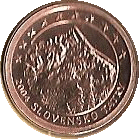 |  | 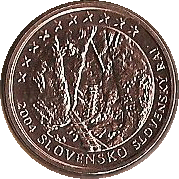 |  | | 1 cent | 2 cent | 5 cent | 10 cent | 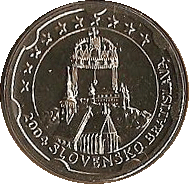 |  | 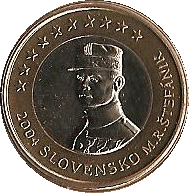 |  | | 20 cent | 50 cent | 1 euro | 2 euro |
In July 2004, the National Bank of Slovakia opens a competition to choose the designs of the Slovak coins. In a first phase, 56 artists proposed 64 projects containing 658 drawings of the eight facial values (including alternative solutions). Experts of the National Bank of Slovakia, experts of the scientific and cultural institutions of the Slovak Republic, as well as the representatives of the graphic designers took part in the process of evaluation. 36 drawings were selected for the second turn. Those represented 17 topics, such as personalities, architecture, symbolic elements and other characteristic features of the historical and cultural heritage of Slovakia. The national Bank of Slovakia preselected 10 drawings and their originators were requested to create plaster models of their project.
| The 10 preselected projects |  | 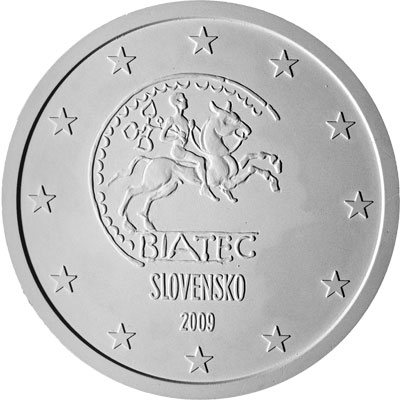 | 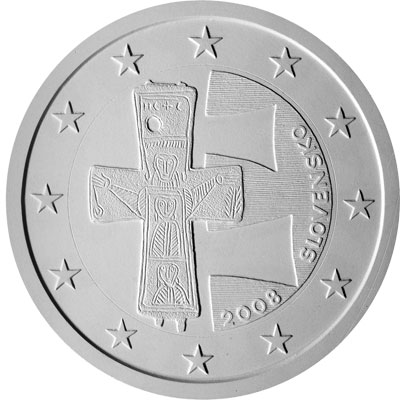 | 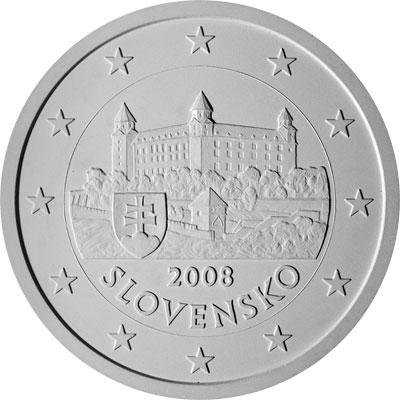 | | Project 1: Double cross et 3 hills | Project 2: Historical coin of Biatec | Project 3: Crucifix of Vel'ká Maca | Project 4: Bratislava Castle | 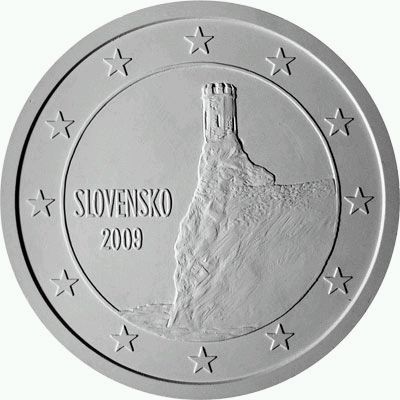 | 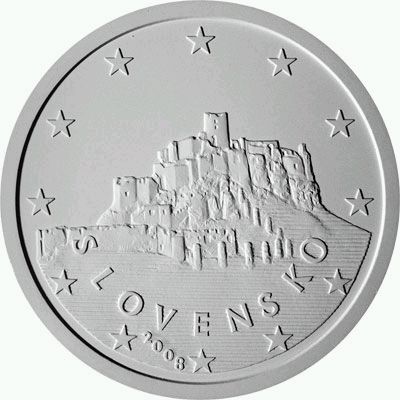 | 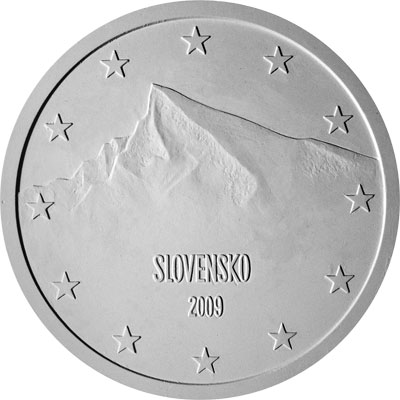 |  | | Project 5: Devin Castle | Project 6: Spiš Castle | Project 7: Krivan | Project 8: St Mary of Kremnice |  |  | | Project 9: St Mary of Levoci | Project 10: Saints Cyril and Methodius |
At the second turn of the competition, the plaster models of the coins were judged by the public over the period of the 12 at November 20, 2005. The citizens then could deliver their opinion on the various projects, via public opinion surveys, and thus influence into the choice of the graphics of the future national sides of the Slokak Euros.
| Results of voting | | Rank | Projet nr | Nomber of votes | | 1 | 1 | 33.068 | | 2 | 7 | 24.589 | | 3 | 4 | 21.792 | | 4 | 6 | 14.962 | | 5 | 10 | 13.204 | | 6 | 3 | 7.340 | | 7 | 8 | 7.138 | | 8 | 5 | 6.424 | | 9 | 9 | 6.203 | | 10 | 2 | 5.933 | | Total | 140.653 |
This led to one non official first Slovak series, in which each coin had a different pattern. Unfortunately, the first official series will only keep the three best ranked projects. At this time, none of the coins has the initials of their engravers, nor even the mintmark. One can even notice that on the cents coins, the blazon with the double cross is missing. Slovakia has its own mintshop at Kremnica, and it is one of the oldest in the world, it mints since 1328. The mintmark  depicts the two stamps which come to strike the coins during their manufacturing, with, in the middle, the initials of the Mincovňa Kremnica, the whole being inside a circle. One can notice that the double cross is an important symbol for Slovakia because it fills the whole inner circle surface of the 1 and 2 euro coins, and because it can be found in a little blazon on all other national sides. depicts the two stamps which come to strike the coins during their manufacturing, with, in the middle, the initials of the Mincovňa Kremnica, the whole being inside a circle. One can notice that the double cross is an important symbol for Slovakia because it fills the whole inner circle surface of the 1 and 2 euro coins, and because it can be found in a little blazon on all other national sides. The three best ranked projects are adopted:
- 1, 2 and 5 cent: Tatra mountain peak, Krivan, important site for the awaking of the Slovak national conscience. 'SLOVENSKO' is below mid-center
- 10, 20, 50 cent: Bratislava castle, the state emblem of Slovakia. 'SLOVENSKO' is at the bottom-center
- 1 et 2 euro: the double cross in the middle of three hills, cross which appears on the national flag. The cross is sustained by the hills in order to express the stability. 'SLOVENSKO' is at the bottom-right corner, along the edge of the inner circle
| In 2009 | 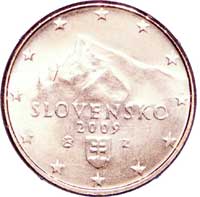 | 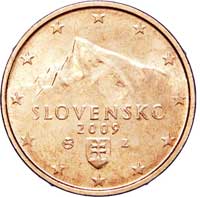 | 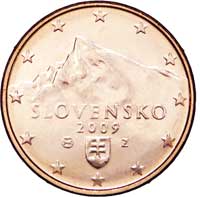 | 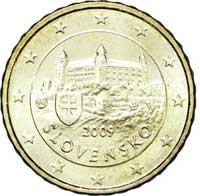 | | 1 cent | 2 cent | 5 cent | 10 cent | 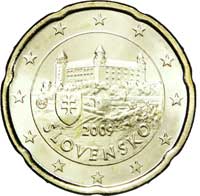 | 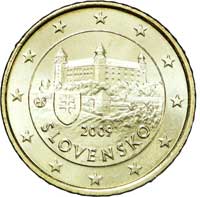 | 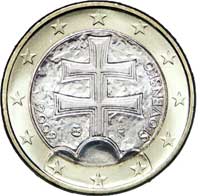 | 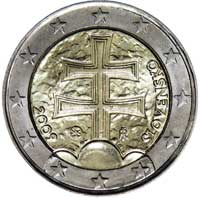 | | 20 cent | 50 cent | 1 euro | 2 euro |
The 2 euro commemorative coins Hardly Slovakia adheres to the common currency, that it mints in 2009 not one but two commemorative coins: | The 2 euro commemorative coins | | 2009 | 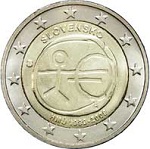 | 10th anniversary of EMU (Common issue of the 16 countries)
| | 20th anniversary of 17 november 1989 Day of the fight for freedom and democracy |
To be noticed, the plural of Slovak words: one says 1 cent, 2 centy but 5 centov... In fact, the plural in "-y" is valid only for the numbers 2, 3 and 4. From 5 on, the ending is "-ov". - 400 millions coins to prepare transition
- So far, the banknotes emission is not known
Contact E-mail: pays@amisdeleuro.org Links - Central Bank of Slovakia: http://www.nbs.sk/ - Mint of Slovakia: http://www.mint.sk/
|
 AD€ - Les Amis de l'Euro
AD€ - Les Amis de l'Euro




























